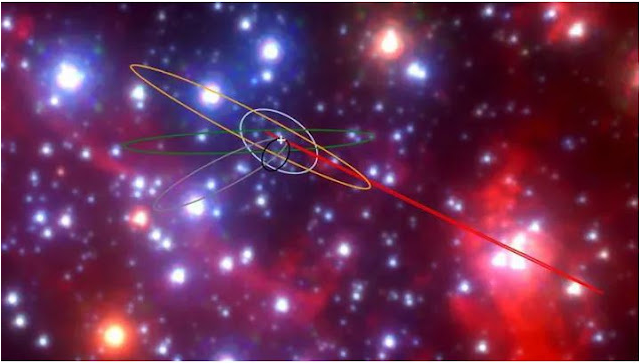Every seventy minutes, astronomers have found a mystery object that they think is a massive hot bubble of gas circling the Milky Way's black hole. This indicates a staggering 30% of the speed of light for the object's rate of motion.
The supermassive black hole of the Milky Way has been discovered to be home to an uncommon object according to observations made by the Atacama Large Millimeter/submillimeter Array (ALMA). A hot spot, or mystery item, is thought to circle Sagittarius A*, according to astronomers. The discovery, according to the experts, will help us better understand the peculiar yet dynamic ecology.
According to the specialists, the object that travels around the black hole is most likely a hot gas bubble that orbited Sagittarius A* in an orbit similar to that of the planet Mercury. The sole distinction is that it finishes an orbit in about 70 minutes.
Orbits of the G objects near the galactic core, with a white cross indicating the location of the supermassive black hole. In the distance, there are stars, gas, and dust. (Credit: Tuan Do/UCLA Galactic Center Group, Anna Ciurlo)
In other words, for this mysterious object to complete its orbit in 70 minutes, Maciek Wielgus of the Max Planck Institute for Radio Astronomy in Bonn, Germany, estimates a mind-boggling velocity of about 30% of the speed of light. The research, by Wielgus, was presented in the journal Astronomy & Astrophysics and described the hot gas bubble surrounding the black hole.
The Event Horizon Telescope (EHT) Collaboration used images from ALMA, a radio telescope that is jointly owned by the European Southern Observatory (ESO), to try to detect black holes. The EHT joined eight other radio telescopes, including ALMA, in April 2017 to take the first-ever image of Sagittarius A*, the black hole at the centre of the Milky Way galaxy. A group of EHT Collaboration members, including Wielgus, used ALMA data collected concurrently with the EHT observations of Sagittarius A to calibrate the EHT data. Using only ALMA observations, the researchers learned more about the black hole's characteristics.
The observations were made immediately following the Chandra Space Telescope's discovery of an X-ray flare emanating from the centre of our galaxy. Hot spots, hot gas bubbles that orbit extremely swiftly and close to black holes, are thought to be the source of these flares. They were previously observed with the use of infrared and X-ray telescopes.
This is particularly noteworthy because only X-rays and infrared were ever used to record flares of this kind in the past. According to Wielgus, "for the first time, we find a very strong signal that orbiting hot spots are also present in radio data."
The hot spots identified at infrared wavelengths, according to Jesse Vos, a Ph.D. student at Radboud University who was also involved in this study, are most likely manifestations of the same physical phenomenon: as hot spots emitting infrared cool, they become visible at longer wavelengths, similar to those observed by ALMA and the EHT.
The idea that flares are produced by magnetic interactions in the extremely hot plasma encircling the black hole is supported by recent findings. The geometry of these flares is elucidated by science, and they seem to have a magnetic origin. Because of the new information, we can now construct a theoretical interpretation of these events "explains Monika Mocibrodzka, a co-author from Radboud University.
Utilizing ALMA, researchers may determine Sagittarius Amagnetic *'s field by analysing polarised radio waves. In addition to these results, the researchers used theoretical models to examine the hot spot's origin and surroundings, specifically the magnetic field surrounding Sagittarius A*. In the process of understanding the characteristics of our black hole and its surroundings, their discovery places more restrictions on the shape of this magnetic field than earlier findings.
Some of the earlier findings have been confirmed by the GRAVITY instrument on ESO's Very Large Telescope (VLT), which studies the cosmos in infrared. The flare is thought to begin in a cluster of gas rotating clockwise around the black hole at around 30% the speed of light, according to GRAVITY and ALMA data. The orbit of the hot spot is also almost face-on, according to researchers.
Using GRAVITY and ALMA coordinated multiwavelength data to track hot spots at various wavelengths in the future would be a real breakthrough for our comprehension of the physics of flares in the Galactic centre, "Ivan Marti-Vidal, a study co-author from the University of Valencia, adds.
In order to get closer and learn more about the object, the EHT team also plans to physically analyse the gas clumps surrounding the black hole.
The atmosphere surrounding Sagittarius Acosmic * is a mystery to researchers. Wielgus, on the other hand, believes that eventually we might discover more about it and be able to create a clearer picture of what occurs at the galactic centre.






0 Comments